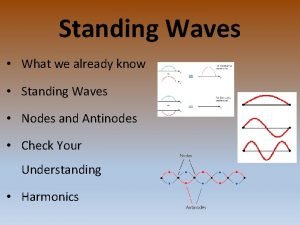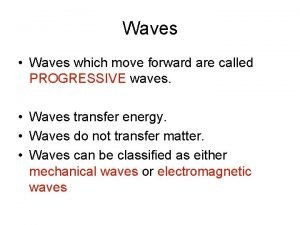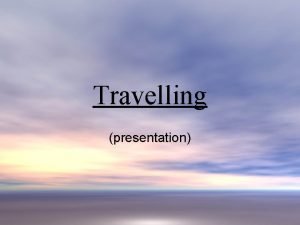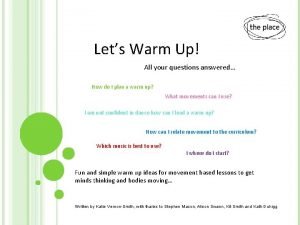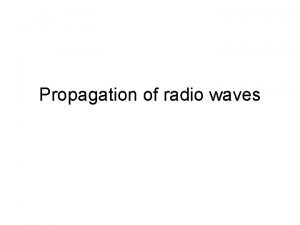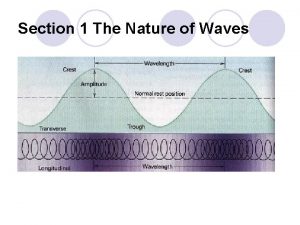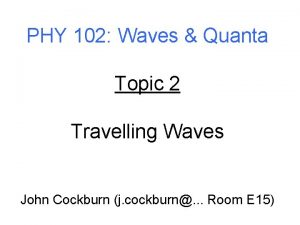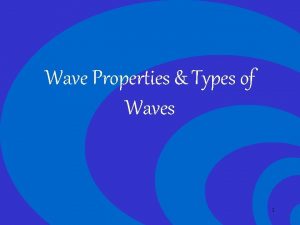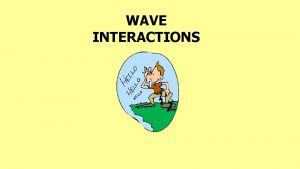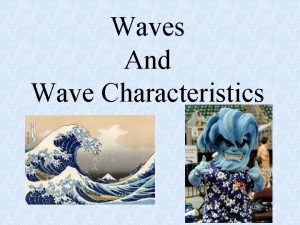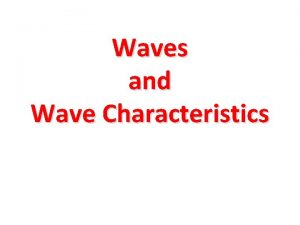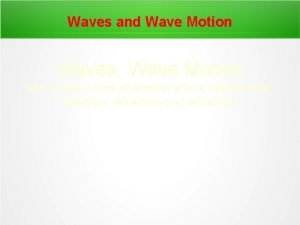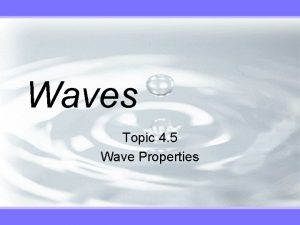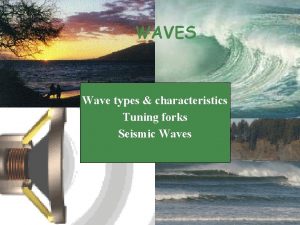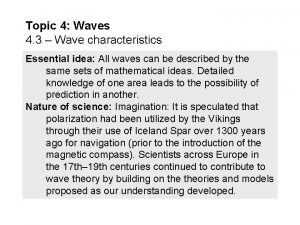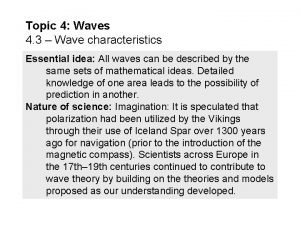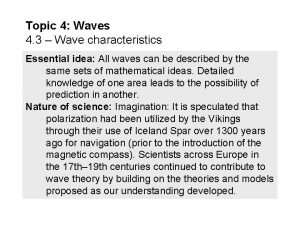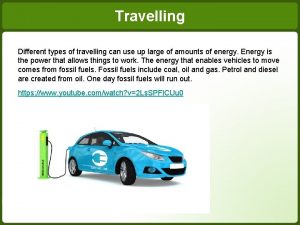Waves Topic 4 4 Wave characteristics Travelling Waves

















































- Slides: 49

Waves Topic 4. 4 Wave characteristics

Travelling Waves v. There are two types of waves and pulses that we encounter in the physical world.

Transverse v. In these waves the source that produces the wave oscillates at right angles to the direction of travel of the wave v. It means that the particles of the medium through which the wave travels also oscillates at right angle to the direction of travel of the wave.

Transverse Wave Direction of oscillation of the particles Direction of travel of the wave

Longitudinal v. In these waves the source that produces the wave oscillates in the same direction as the direction of travel of the wave v. It means that the particle of the medium through which the wave travels also oscillates in the same direction as the direction of travel of the wave.

Longitudinal Wave Direction of oscillations of the particles Direction of travel of the wave

Discrete Pulses and Continuous Waves v. A single shake of a slinky will send a discrete pulse down it v. Shake the slinky up and down and a continuous travelling wave travels down it v. This applies to longitudinal waves too



What is a Wave? v. A wave is a means by which energy is transferred between two points in a medium without any net transfer of the medium itself.

The Medium v. The substance or object in which the wave is travelling. v. When a wave travels in a medium parts of the medium do not end up at different places v. The energy of the source of the wave is carried to different parts of the medium by the wave.

v. Water waves however, can be a bit disconcerting. v. Waves at sea do not transport water but the tides do. v. Similarly, a wave on a lake does not transport water but water can actually be blown along by the wind.

v. However, if you set up a ripple tank you will see that water is not transported by the wave set up by the vibrating dipper.

Periodicity v. A very important property associated with all waves is their socalled periodicity. v. Waves in fact are periodic both in time and space and this sometimes makes it difficult to appreciate what actually is going on in wave motion.

v. If we drew a diagram that froze time on waves in water van instantaneous snapshot of the whole of the water surface v. The next diagram shows the periodicity of the wave in space

Displacement / Distance displacement p distance

v. The y-axis shows the displacement of the water from its equilibrium position v. The graph is a displacementdistance graph.

v. We now look at one part of the wave that is labeled p and "unfreeze" time v. The next diagram shows how the position of p varies with time v. This illustrates the periodicity of the wave in time

Displacement / Time displacement of point p from equilibrium position time

v. The y-axis now shows the displacement of the point p from equilibrium v. The graph is a displacement-time graph.

v. The space diagram and the time diagram are both identical in shape v. If we mentally combine them we have the whole wave moving both in space and time.

And for Longitudinal Waves? v. For the longitudinal wave in the slinky spring the displacementdistance graph actually shows the displacement of the individual turns of the spring from their equilibrium position as a function of distance along the spring.

However v. It could equally show the density of turns of the spring varies with length along the spring.

v. The displacement-time graph shows the displacement of one turn of the spring from its equilibrium positions as a function of time.

Definitions v. The following definitions are given in terms of the particles that make up the medium through which the wave travels. v. For the slinky spring a particle would be a single turn of the spring v. For the water waves a particle would be a very small part of the water.

Wavefront • All the points that started from a source at one time make up the whole of that wavefront, • If it was a single point, it will be a circular wavefront • If it is a straight line, it will be a straight wave front

Displacement v(s) is the distance that any particle is away from its equilibrium position at an instance v. Measured in metres

Amplitude v(A, a) This is the maximum displacement of a particle from its equilibrium position v(It is also equal to the maximum displacement of the source that produces the wave). v. Normally measured in metres

Period v(T) This is the time that it takes a particle to make one complete oscillation v(It also equals the time for the source of the wave to make one complete oscillation). v. Measured in seconds

Frequency v(f) This is the number of oscillations made per second by a particle v(It is also equal to the number of oscillations made per second by the source of the wave) v. The SI unit of frequency is the hertz Hz. (1 Hz is 1 oscillation per second) v. Clearly then, f = 1/T

Wavelength v( ) This is the distance along the medium between two successive particles that have the same displacement and the same phase of motion. v. Measured in metres

Wave Speed v (v, c) This is the speed with which energy is carried in the medium by the wave. v. Measured in ms-1 v. A very important fact is that wave speed depends only on the nature and properties of the medium

Crest v. This is a term coined from water waves and refers to the points at the maximum height of the wave.

Trough v A term coined from water waves referring to the points at the lowest part of the wave.

Wavelength again! v. Wavelength will therefore be equal to the distance between successive crests and successive troughs.

Compression v. This is a term used in connection with longitudinal wave and refers to the region where the particles of the medium are "bunched up". v. High density v. High pressure

Rarefaction v. A term used in connection with longitudinal waves referring to the regions where the particles are "stretched out". v. Low density v. Low pressure

Longitudinal Waves v. The wavelength will be equal to the distance between successive points of maximum compression and successive points of maximum rarefaction. v. The compression is the region in which the molecules of the air are pushed together v. The rarefaction is the region where the molecules move apart.

rarefactions wavelength

Sound Waves v. A longitudinal wave in a slinky spring is analogous to a sound wave in which each turn of the spring represents an air molecule.

Interpreting Graphs - 1 displacement amplitude crest wavelength amplitude trough distance

Interpreting Graphs - 2 displacement amplitude period time

Deriving v = f v. Imagine a wave with velocity v v. Being produced from a source of frequency f v. In 1 second the 1 st wavefront would have travelled a distance of f v. As speed = distance / time vv = f / 1 v v = f

2 Important Points v 1. The frequency of a wave depends only on the source producing the wave w It will therefore not change if the wave enters a different medium or the properties of the medium change

v 2. The Speed of waves only depends on the nature and the properties of the medium w w Water waves do travel faster in deeper water Light travels slower in more optically dense material

The EM Spectrum Itself Long Low f Radio Micro Waves Short High f Infra VISIBLE red Ultra X Violet rays Gamma rays

Frequencies of Regions (Hz) • Gamma Rays >1021 • X-rays 1017 - 1021 • Ultraviolet 1014 - 1017 • Violet 7. 5 x 1014 > Visible > Red 4. 3 x 1014 • Infrared 1011 -1014 • Microwaves 109 -1011 • Radio and TV < 109

The Different Regions v. In the context of wave motion, common properties of all parts of the electromagnetic spectrum are w w w all transverse waves all travel at the speed of light in vacuo (3. 0 x 108 ms-1) all can travel in a vacuum

Sources of Regions w w w w Gamma – certain radioactive material’s nuclei X-rays – by firing an electron stream at a tungsten metal target in a highly evacuated tube. Ultraviolet – the Sun, ultraviolet lamp Visible – hot bodies Infrared – the Sun (heat), hot bodies Microwaves – Ovens, communication systems Radio and TV – transmitter stations, Azteca TV
 Nodes and antinodes
Nodes and antinodes Progressive waves travelling disturbances that transfer
Progressive waves travelling disturbances that transfer Clincher sentence example
Clincher sentence example Narrowed down topic examples
Narrowed down topic examples Commercial vehicle meaning
Commercial vehicle meaning Travelling movimiento de camara
Travelling movimiento de camara Travelling mattes
Travelling mattes Travelling salesman problem discrete mathematics
Travelling salesman problem discrete mathematics Presentation travelling
Presentation travelling Prefer to do or doing
Prefer to do or doing Savings heuristik
Savings heuristik Travelling camera
Travelling camera Last summer mike's elder brother
Last summer mike's elder brother Objectives of travelling
Objectives of travelling I was travelling
I was travelling Who is travelling at the lowest speed
Who is travelling at the lowest speed Tongue twister about travelling
Tongue twister about travelling Travelling salesman problem
Travelling salesman problem Let's warm up together
Let's warm up together Connector problem in graph theory
Connector problem in graph theory Past continuous travel
Past continuous travel Travelling salesman problem ppt
Travelling salesman problem ppt Scatters mobiili
Scatters mobiili Public facilities relate to people's
Public facilities relate to people's Sound is a transverse wave true or false
Sound is a transverse wave true or false Carbon dioxide temperature
Carbon dioxide temperature Difference between full wave and half wave rectifier
Difference between full wave and half wave rectifier Example of longitudinal wave
Example of longitudinal wave Half wave rectifier definition
Half wave rectifier definition Full wave rectifier with centre tapped transformer
Full wave rectifier with centre tapped transformer Determining the arrival times between p-wave and s-wave
Determining the arrival times between p-wave and s-wave Rectified sine wave fourier series
Rectified sine wave fourier series What is a repeating disturbance
What is a repeating disturbance The wave chapter 10
The wave chapter 10 Fourier series
Fourier series Mechanical waves vs electromagnetic waves venn diagram
Mechanical waves vs electromagnetic waves venn diagram Example of a mechanical wave
Example of a mechanical wave Transverse wave and longitudinal wave example
Transverse wave and longitudinal wave example Ability of two or more waves to combine and form a new wave
Ability of two or more waves to combine and form a new wave Difference between mechanical and electromagnetic waves
Difference between mechanical and electromagnetic waves Mechanical and electromagnetic waves similarities
Mechanical and electromagnetic waves similarities What type of waves are sound waves? *
What type of waves are sound waves? * Sound is a longitudinal wave
Sound is a longitudinal wave Mechanical waves and electromagnetic waves similarities
Mechanical waves and electromagnetic waves similarities Mechanical waves vs electromagnetic waves
Mechanical waves vs electromagnetic waves Mechanical and electromagnetic waves similarities
Mechanical and electromagnetic waves similarities Surface waves and body waves
Surface waves and body waves Seismic waves are mechanical waves
Seismic waves are mechanical waves Compare and contrast p waves and s waves using venn diagram
Compare and contrast p waves and s waves using venn diagram Differences between constructive and destructive waves
Differences between constructive and destructive waves
